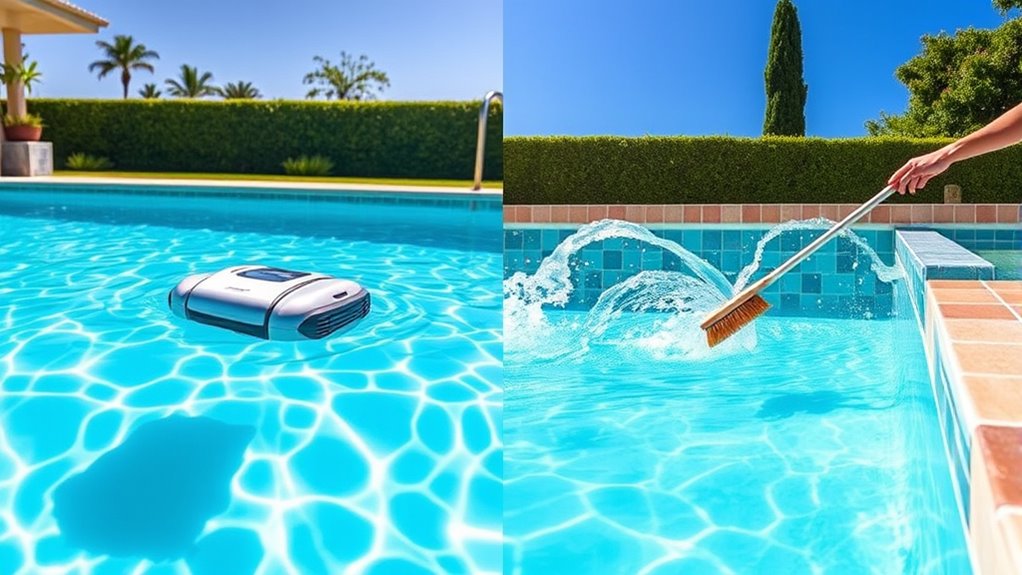Automatic pool cleaners save you time and effort by steering and cleaning your pool efficiently, reaching tricky spots, and reducing manual work. They’re often energy-efficient but require an upfront investment and ongoing maintenance. Manual cleaning is cheaper and gives you full control but takes more time and physical effort, with some areas easier to miss. To find out how each option compares in costs and benefits, keep exploring the details.
Key Takeaways
- Robotic cleaners save time, cover entire surfaces efficiently, and can be scheduled, but require higher initial costs.
- Manual cleaning offers low upfront costs and tactile control but demands more effort and time for thoroughness.
- Automated systems are energy-efficient, environmentally friendly, and reduce debris buildup, extending equipment lifespan.
- Manual methods are budget-friendly upfront but may lead to higher long-term costs due to increased wear and maintenance.
- Robotic cleaners feature modern technology for remote operation and monitoring, whereas manual cleaning allows direct inspection and control.

When it comes to maintaining a clean and healthy pool, choosing between automatic and manual cleaning methods can make a significant difference. If you’re considering your options, it’s helpful to understand how robotic technology, used in many automatic cleaners, stacks up against manual maintenance techniques that rely on your effort and skill. Robotic pool cleaners are designed to navigate your pool independently, using sensors and brushes to scrub surfaces and collect debris without much intervention. They’re convenient, saving you time and physical effort, especially if you have a large or complex pool. These devices can be programmed to clean on a schedule, ensuring consistent maintenance without your constant supervision. On the other hand, manual maintenance techniques involve physically skimming, brushing, and vacuuming the pool yourself or with basic tools. This approach requires more time and effort but gives you direct control over the cleaning process.
Automatic cleaners, particularly those equipped with advanced robotic technology, tend to be more efficient at covering the entire pool surface. They can easily reach corners and tight spots that manual cleaners might miss or require extra effort to clean thoroughly. Plus, robotic pool cleaners often come with built-in filters that trap debris and dirt, which means you spend less time dealing with clogged skimmers or floating leaves. They’re especially useful if you dislike manual chores or have a busy schedule, as they handle routine cleaning with minimal input. Additionally, robotic pool cleaners are generally designed with advanced navigation systems that enhance their ability to cover the entire area systematically. Modern models also incorporate energy-efficient motors, reducing their power consumption and environmental impact compared to traditional pool cleaning methods. Some models even feature smart technology, allowing for remote control and monitoring via smartphone apps, providing even greater convenience. Using automation in pool maintenance can also extend the lifespan of your pool equipment by preventing debris buildup that might cause damage over time. Furthermore, robotic cleaners typically require less water and cleaning solution, making them more environmentally friendly overall.
Manual maintenance techniques, while less costly initially, demand regular effort from you. Skimming the surface, brushing walls, and vacuuming the bottom can be time-consuming, especially during peak swimming season when your pool gets more use and debris. But some pool owners prefer this hands-on approach because it allows them to spot issues early, like algae growth or equipment problems. Plus, manual cleaning doesn’t require the ongoing expenses associated with robotic technology, making it a budget-friendly choice for those willing to put in the work. Relying on manual methods also gives you a chance to inspect your pool’s condition closely, helping to identify potential repairs before they become costly. Ultimately, your decision hinges on how much time you want to dedicate to pool care, your budget, and your comfort level with technology. Both methods have their advantages and drawbacks, so weigh them carefully to find what best suits your lifestyle and pool maintenance needs. For example, understanding the cost benefits of manual cleaning can help you decide if the upfront savings outweigh the convenience of automation.
Frequently Asked Questions
How Often Should I Manually Clean My Pool?
You should manually clean your pool at least once a week to keep it sparkling. During this time, do manual scrubbing of the walls and floor to remove algae and debris, and check the chemical balancing to make certain water stays safe and clear. If your pool gets heavy use or experiences a lot of debris, increase cleaning frequency accordingly. Regular manual maintenance helps prevent bigger issues and keeps your pool inviting.
Can Automatic Cleaners Handle Leaf Debris Effectively?
Automatic cleaners can handle leaf debris effectively, especially on the pool surface. They are designed to pick up larger debris like leaves, reducing your manual cleaning time. However, for heavy or stubborn debris, you might need to occasionally assist or manually remove leaves to guarantee the pool stays crystal clear. Overall, automatic cleaners are a convenient way to keep your pool surface free of leaf debris with minimal effort.
What Maintenance Is Required for Automatic Pool Cleaners?
You’ve got to keep your eye on the ball when it comes to automatic pool cleaners. Regular maintenance includes checking the pool chemical balance to prevent debris buildup and ensuring the equipment stays durable. Clean filters often, inspect hoses for leaks, and clear out debris from the cleaner’s components. Doing these simple tasks helps your cleaner run smoothly and last longer, saving you time and money in the long run.
Are There Safety Concerns With Robotic Pool Cleaners?
You might wonder about robotic safety when considering automatic pool cleaners. Generally, robotic pool cleaners are safe if used properly, but there are automatic hazards to watch out for, such as electrical faults or getting stuck. Always follow manufacturer instructions, guarantee the unit is unplugged during maintenance, and keep the power supply away from water to minimize risks. Proper use ensures your robotic cleaner stays a safe, efficient tool in your pool.
How Long Do Manual Pool Cleaning Tools Typically Last?
Manual pool cleaning tools usually last between 3 to 5 years, depending on usage and maintenance. To prolong their lifespan, you should regularly check your pool chemistry and keep filters clean. Properly maintaining your tools ensures they work effectively and last longer. Avoid harsh chemicals that can degrade the equipment, and rinse tools after use to prevent buildup, which helps your manual tools stay in good shape for years.
Conclusion
Choosing between automatic and manual pool cleaning isn’t just about convenience—it’s about understanding what truly suits your needs. While many believe automatic cleaners always save time, recent studies suggest they might miss spots, requiring manual touch-ups. Conversely, manual cleaning offers control but demands effort. The real truth? A hybrid approach often gives you the best of both worlds, ensuring your pool stays pristine without breaking the bank or your back. Your perfect pool care routine might surprise you!










